
As an example, let's take a look at the rubric Generalities; Food and drinks; apples; desires:
If you want to know more about a remedy in a rubric, the easiest way is to move the mouse over the remedy name, and look at the message area at the lower left bottom of the window.
If the mouse is moved over ant-t, the message shows:
You now know not only that Antimonium is in the third grade (by the way it is printed), but also that its complete name is Antimonium tartaricum, and that it is in this rubric because the four mentioned authors have contributed this information.
To get more information, double click on ant-t.
This will bring up the Remedy Information window:
Related rubrics are rubrics that have some kind of relationship with the rubric you are viewing for this remedy.
In this example, these rubrics are:
Generalities; Food and drinks; cool things, like apples, desires
Generalities; Food and drinks; apples, desires; water, with desire for cold
Both of these rubrics also contain ant-t.
The higher the number of occurrences in related rubrics, and the higher the average weight in these rubrics, the more importance can be assigned to the remedy.
Lists all the sources the remedy originates from. This includes at least the author name, the book or magazine title, and the year of publication.
If you have previously been working with MacRepertory, you might be accustomed to using author numbers instead of author names.
In the preferences settings, you can activate the option Author numbers. See the section Preferences for details.
The remedy information window will then show the author numbers as well: